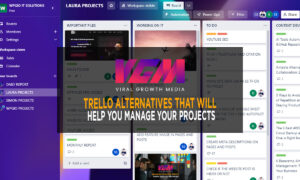Businesses are always looking for ways to improve efficiency and save money. Software as a Service (SaaS) is growing in popularity. SaaS allows businesses to outsource software needs and pay for them every month. This service has several advantages, which we will discuss in this blog post. If you’re thinking about making the switch to SaaS, read on! You may be surprised at how beneficial it can be for your business.
SaaS can save your business money in several ways. First, you don’t have to pay for costly software licenses upfront. With SaaS, you can spread the cost of the software over time. This can be a big advantage for businesses with limited budgets. Second, SaaS providers often offer discounts for customers who commit to longer-term contracts. You could save even more money by signing up for a longer-term plan.
In addition to saving money, SaaS can help improve your business’s efficiency. You don’t have to worry about installing or updating software with SaaS. The provider takes care of all of that for you. This frees up your time to focus on other aspects of your business. SaaS can also make it easier for your employees to collaborate. For example, if you’re using a SaaS customer relationship management (CRM) system, all your employees can access and update customer information from any location. This can help improve communication and prevent mistakes.
Another advantage of SaaS is that it’s typically more secure than traditional software. When you install software on your servers, there’s always the risk that someone will find a way to hack into it. With SaaS, the provider takes care of security for you. Teams of experts often constantly work to identify and fix security vulnerabilities. Knowing that your data is safe and secure can give you peace of mind.

What is SaaS, and what good does it do you to know?
Like many technology trends, “Software as a Service” (SaaS) has entered into the realm of buzzwords that can be confusing and easy to ignore.
SaaS is a type of software where applications are stored off-site by a provider. Customers have access to it through the internet and rent the software instead of buying it outright. Companies usually offer subscription plans that you can pay for monthly or yearly.
SaaS, or software as a service, has been increasing in popularity among businesses for its many advantages. As cloud computing becomes more commonplace, we’re seeing more and more software providers adding SaaS capabilities that could lead to significant gains.
Use our IT Software Product Selection Tool to get tailored recommendations for SaaS providers based on your needs. Answer a few questions and get up to 5 free offers from our technical advisors.
These are the four advantages of SaaS;
1. Cost
SaaS can save you money in several ways. Firstly, it does away with the need for an upfront purchase/installation cost. Additionally, ongoing fees like maintenance and upgrading are no longer necessary. Instead of spending lots of cash on hardware installations, SaaS applications can be quickly, easily downloaded, and kept up to date.
Furthermore, pay-as-you-go models allow firms to pay for only what they need, not unused licenses. Small businesses may find SaaS particularly useful since it gives access to high-cost, high-performance software that would have been unattainable through conventional purchasing methods. Also, the subscription basis of payment eliminates the significant financial risk of costly software.
2. Time
Many believe “time is money,” and fortunately, SaaS may help you save both. Installing many SaaS applications is as simple as having an internet connection and signing up for a login. Furthermore, maintenance responsibilities are passed on to the vendor instead of your IT department. This eliminates additional work hours and downtime to install traditional software. Finally, because SaaS apps have a flatter learning curve, they facilitate quicker adoption throughout your workforce.
3. Scalability & Accessibility
The pay-as-you-go model is one of the best features of SaaS because it allows you to change your usage plan easily. Since the software is hosted externally, you don’t need to give advance notice when you want to make changes. Additionally, web-based use means anyone with internet access can use the software from anywhere in the world.
4. Compatibility
Updates might take a long time and be expensive with the old method. Worse, version incompatibilities among employees can lead to compatibility problems and wasted time. Subscribers may simply log on to already enhanced services using SaaS.
The possibilities are endless, and the advantages of using online software as a service can’t be overstated. Using it correctly may help your company save money, time, and human resources. SaaS can give greater focus and efficiency by eliminating software maintenance and incompatibility difficulties. Like other technology solutions, SaaS has its drawbacks. Before putting any methods into practice, thoroughly research the choices individually. To assist with the messy terrain of SaaS, we’ll soon cover some disadvantages and drawbacks to help you to make well-informed decisions.

What are the benefits of SaaS for businesses?
SaaS, or software as a service, is a type of subscription software that provides users access to the application via the internet instead of installing it on their computer hardware. This delivery model has many benefits, but perhaps the chief among them is its low upfront costs. With SaaS applications, businesses only pay for what they use, making it much more budget-friendly than traditional software models, a crucial consideration for small businesses.
Not only is SaaS flexible, but it is also reliable. Because SaaS applications are hosted in the cloud, they can be accessed from any location and device with an internet connection. This allows employees to work remotely, any time of day.
SaaS applications are also generally more straightforward to use than on-premise software. SaaS vendors prioritize making their solutions friendly and simple to use. This can help companies save time and money by reducing the need for training staff to use new technology.
The top benefits of SaaS;
- Improved accessibility. SaaS allows SMEs to get business-critical information and applications from any place, anytime. Improved access may lead to increased productivity, as employees pick apps that assist them in working smarter and faster. Workers will customize their work experiences by developing personalized apps, similar to how they curate their music preferences today.
- The cost of ownership is reduced in terms of initial investment and continuing maintenance. Businesses simply pay for what they require, so small and medium-sized enterprises can use software that would otherwise need expensive licensing fees. This can potentially assist SMEs in competing with larger businesses in a previously impossible way.
- IT professionals will save time and money. IT staff will be less harassed because third-party providers are liable for software development, administration, hosting, and maintenance.
- Before selecting a SaaS provider, ensure they can meet your company’s data security needs. This includes standards such as end-to-end encryption. Doing this will make you more likely to find a partner whose security protocols match your SME’s requirements.
- All data is stored in the cloud, which is reliable. The days of dusty and bulky server banks are over, and today’s SME is sleek, efficient, and ready to pivot at a moment’s notice. By saving critical data in the cloud, SMEs may save money on office space while also being able to work with information in real-time and use it to make more informed business decisions.
- Anything “out-of-the-box” is simple to set up, rapidly put into action, and will give you quick results. This makes it easier for smaller businesses to adopt new technology and allows them to see a return on their investment in as short as a few months.
- With SaaS tools, the global workforce can now work from any location. This has eliminated many former barriers to entry in hiring, making the process more democratic and open.
- SMEs can benefit from automated upgrades because they give them the latest technologies and features, allowing small businesses to keep up with current trends. This relieves IT personnel of their responsibilities and will enable SMEs to prepare for the future.
- The company provides a cloud-based CRM system with all the functionality you would expect, with some innovative new capabilities. -> The software’s scalability and seamless integration with other SaaS services make it an attractive option for small businesses. SMEs won’t have to purchase hardware or software whenever they want to install a new solution using SaaS. This makes scaling up and adding apps and users straightforward as your business expands and changes.
- Designed with simplicity in mind, it features best practices that have been included. This allows SMEs to conduct proof of concepts and trial new technologies before putting them into production. The low entry barrier also eliminates the need for lengthy employee training programs.
- Many SaaS solutions are created to automate tedious, time-consuming manual operations, resulting in enhanced CX (Customer Experience) and increased employee engagement.

How does SaaS work?
SaaS platforms utilize the cloud delivery model. A software provider will use its servers, databases, etc., or outsource to a cloud contractor to host the application and make it accessible via web browsers on any internet-connected device.
SaaS applications are subscription-based, meaning users pay a monthly or annual fee to access the software. This is opposed to traditional licensed software, where users would purchase the program outright and be responsible for installation, set up, and maintenance themselves.
Typically delivered via a web browser, SaaS apps are sometimes called on-demand computing or application service providers (ASP).
In this case, in the software-on-demand SaaS model, the provider provides network-based access to a single copy of an application developed for SaaS distribution. All customers get the same source code for the app, and new features or functionalities are added to all customers at intervals. Each service level agreement (SLA) determines where each model’s data is stored: locally, in the cloud, or locally and in the cloud.
Software as Service providers makes it easier for businesses to integrate their tools by offering application programming interfaces or APIs. With these integrations, companies can create software that works well with their SaaS products.

Why SaaS For Business Is Getting Popular These Days?
SaaS combines affordability, accessibility, and simplification so that businesses can now easily access complicated software and IT infrastructure components. This is why even large-scale enterprises like SAP and Oracle are adopting the SaaS model. SaaS applications for business are getting popular these days,
Here are the main reasons for it;
-Significant drop in the Costs:
SaaS, or software as a service, is a type of subscription software that doesn’t require an initial investment, upfront costs, or management fees. You only pay for what you use instead of being charged for additional features or services you may not need. This makes SaaS more cost-effective than licensed software and frees up your time since the vendor manages everything on your behalf.
-No Delays:
With previous methods, companies needed to invest in hardware and software for their operations and wait for the full infrastructure setup. However, SaaS eliminates the need for hardware or software installation because the time required is reduced from weeks or months to a few hours, days, or less. As a result, no more delays are possible.
-Easy to Adapt with Changes and Demands:
Scaling a SaaS-based solution is more simple than traditional on-premise solutions. It makes it easy to scale up and down for retailers who need additional resources to accommodate peak workloads during specific times of the year. The Saas model provides better value for scalability requirements than short-term planning and investing in standard software, which would be too costly for retailers.
SaaS fulfills the changing demands of businesses, in addition to scalability. With new software and hardware upgrades becoming more common, companies must upgrade their systems regularly. In contrast to the traditional method in which users are required to acquire new software or hardware for changing needs, SaaS allows for simply upgrading subscriptions as needed.
-Unrestricted Access:
SaaS software applications are hosted on the cloud, so you can access them from anywhere with an internet connection. This means that even if you’re away from the office, you’ll still be able to work on your critical business tasks.
Conclusion
There are many reasons to switch to SaaS, but we’ve outlined four essential advantages. By outsourcing your software needs, you’ll save time and money. You’ll also have access to the latest updates and features, and you’ll be able to scale your software more efficiently. If you’re considering switching to SaaS, now is a great time! Contact us today for more information.























